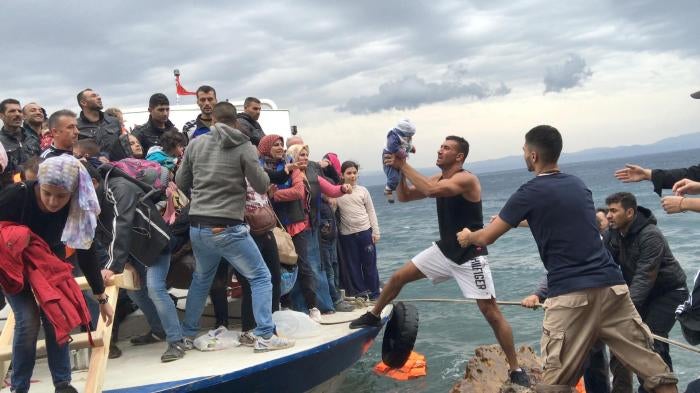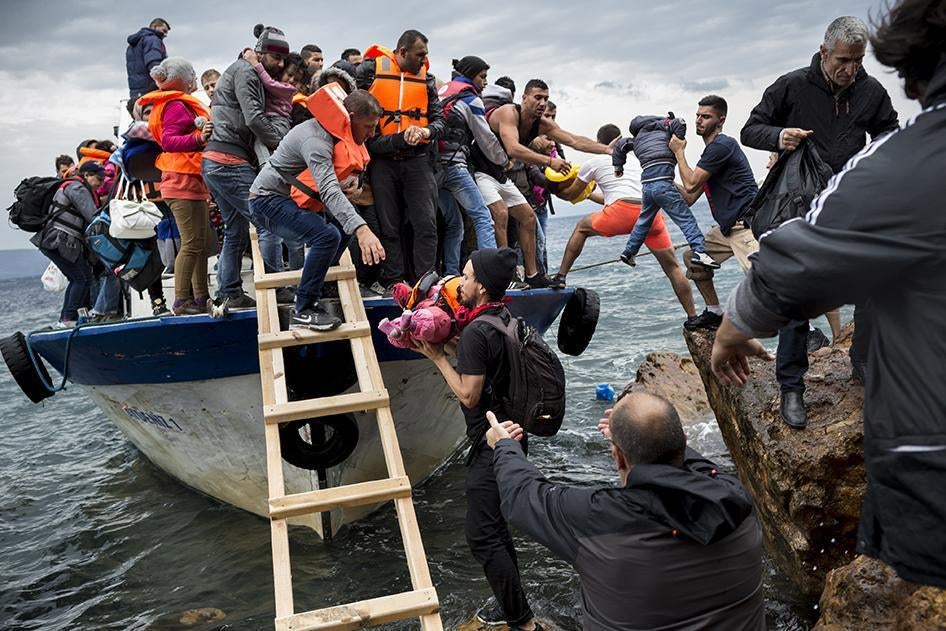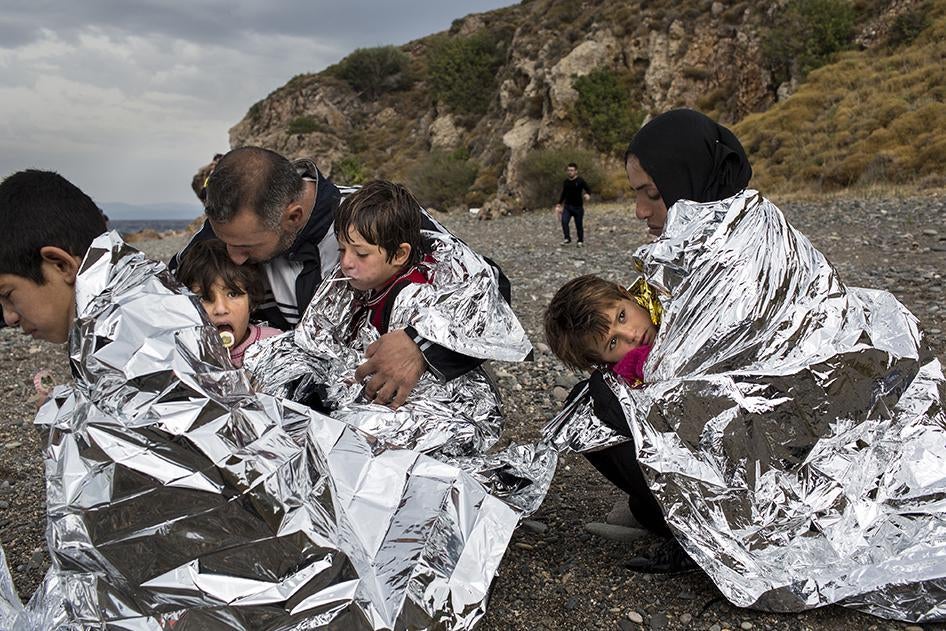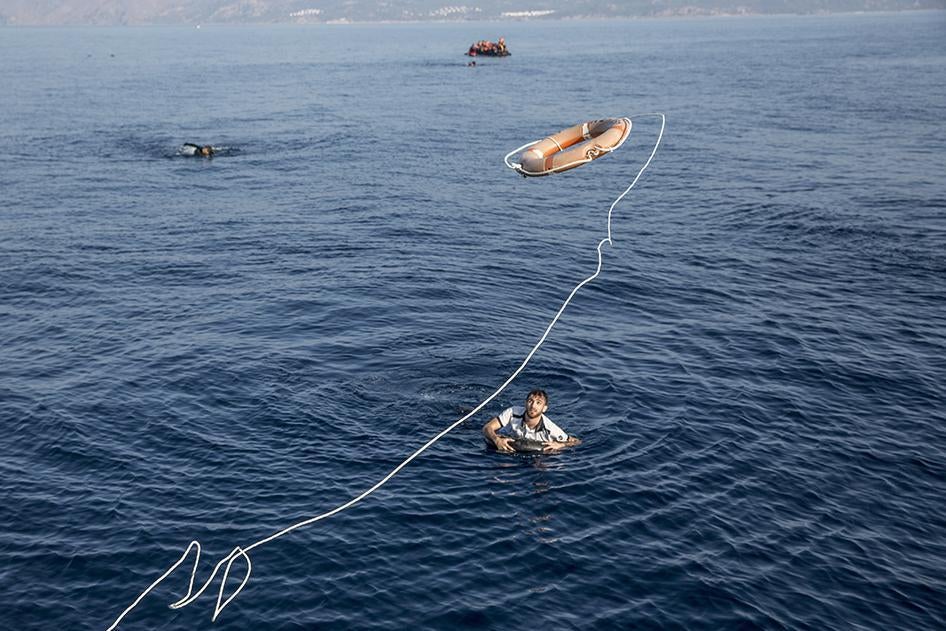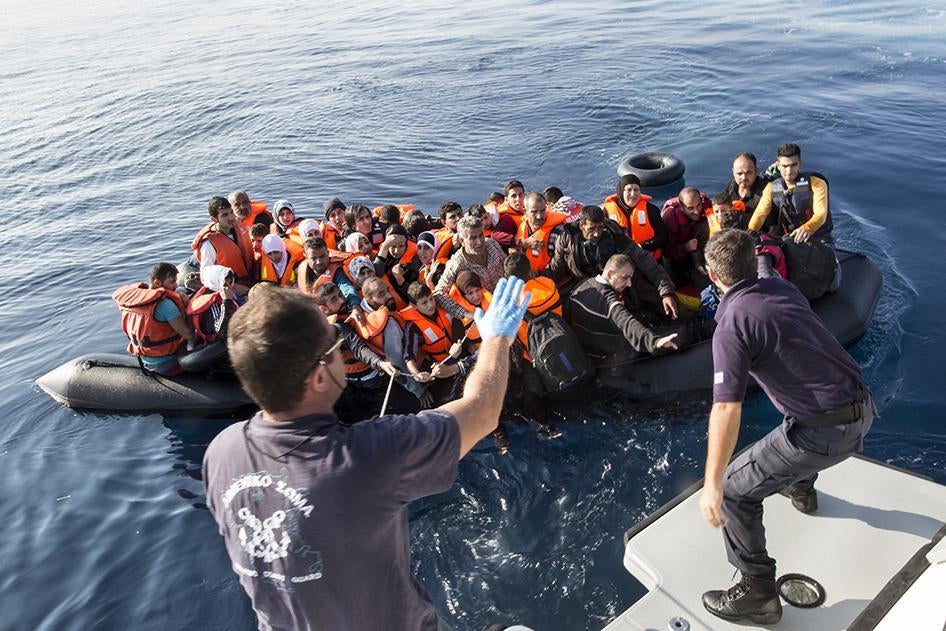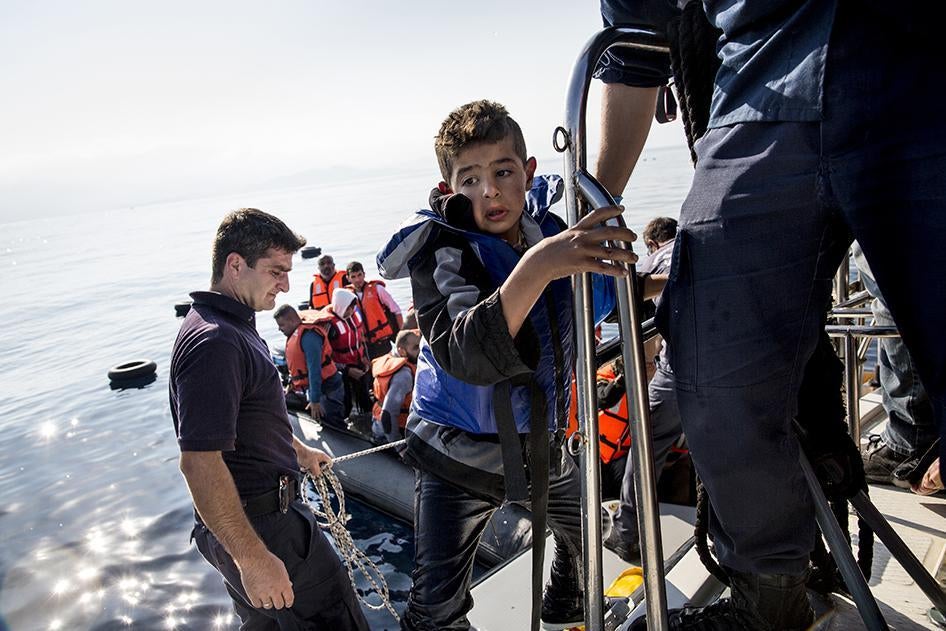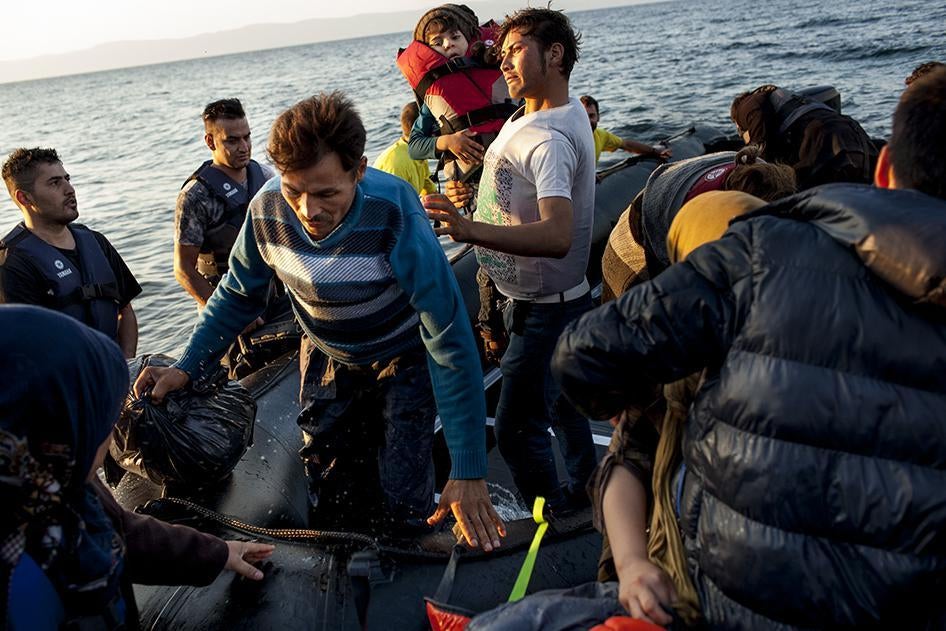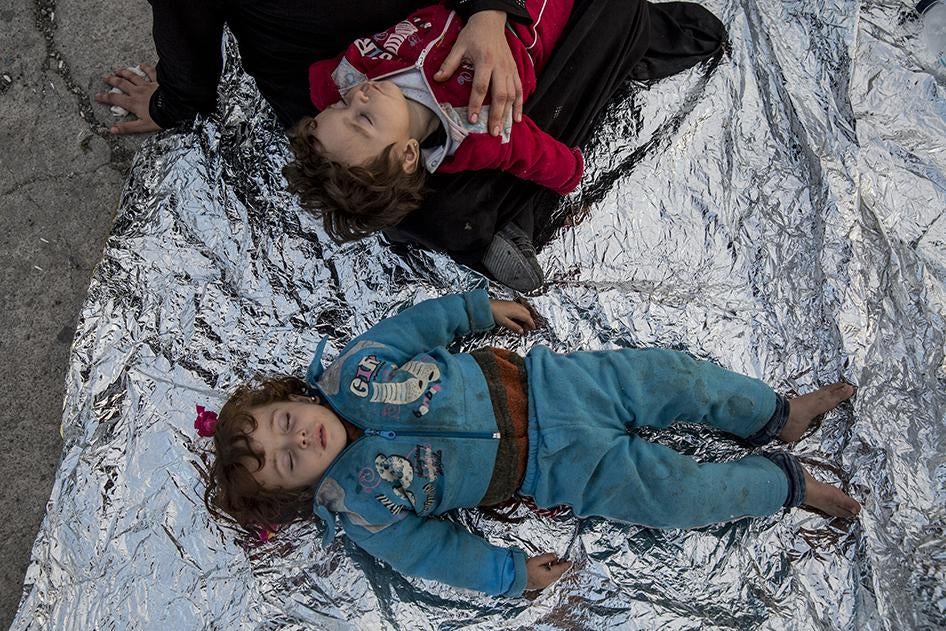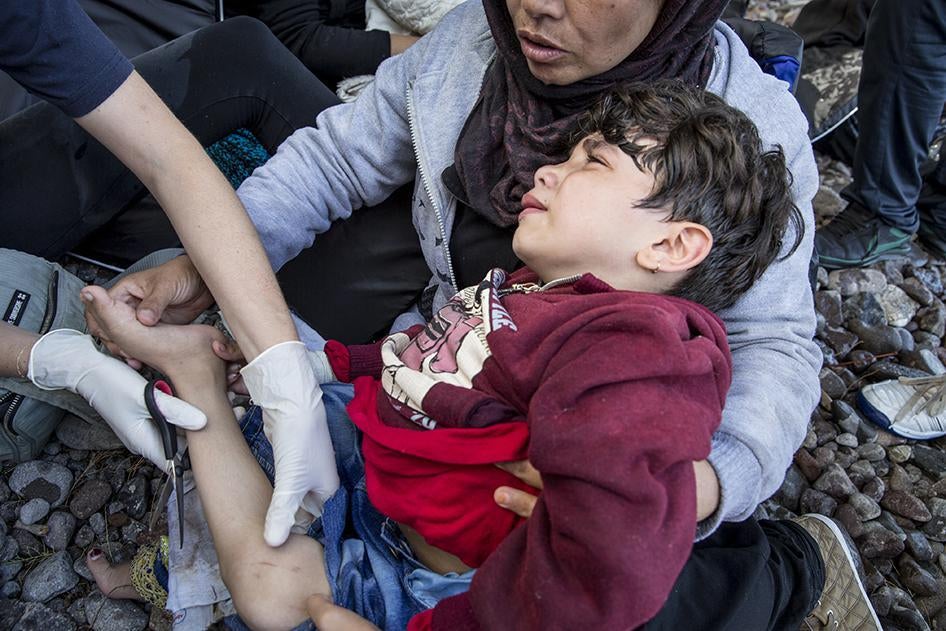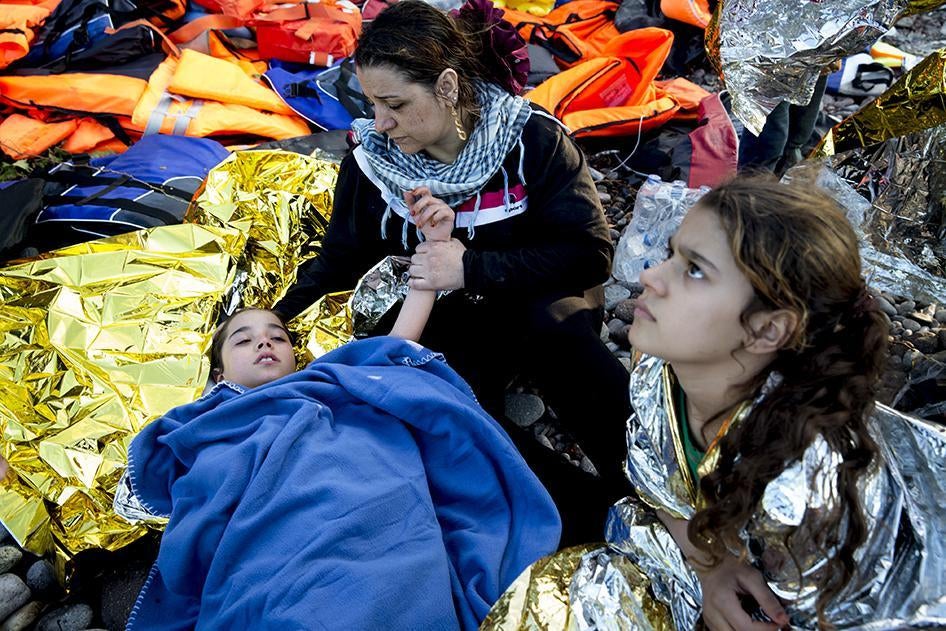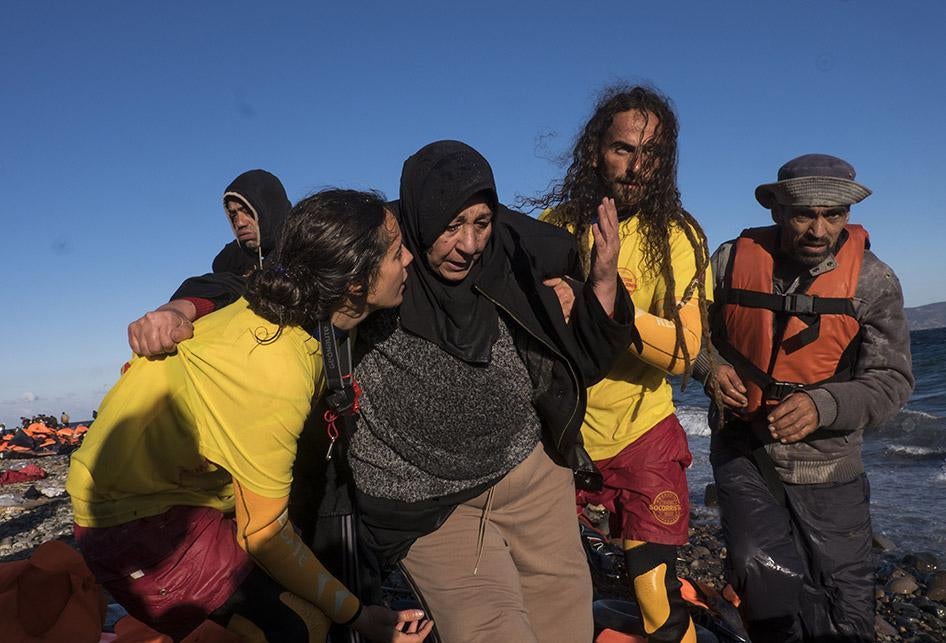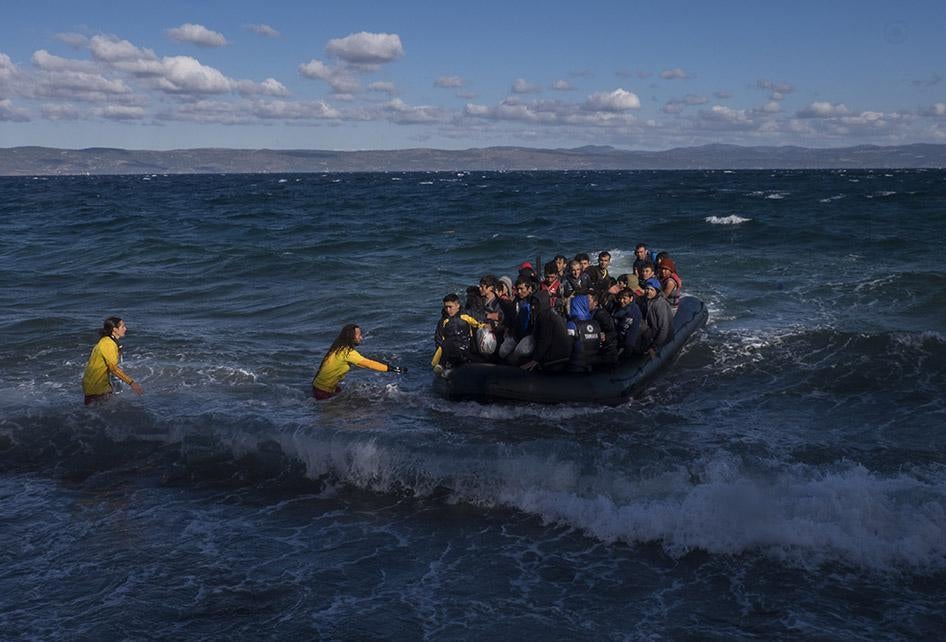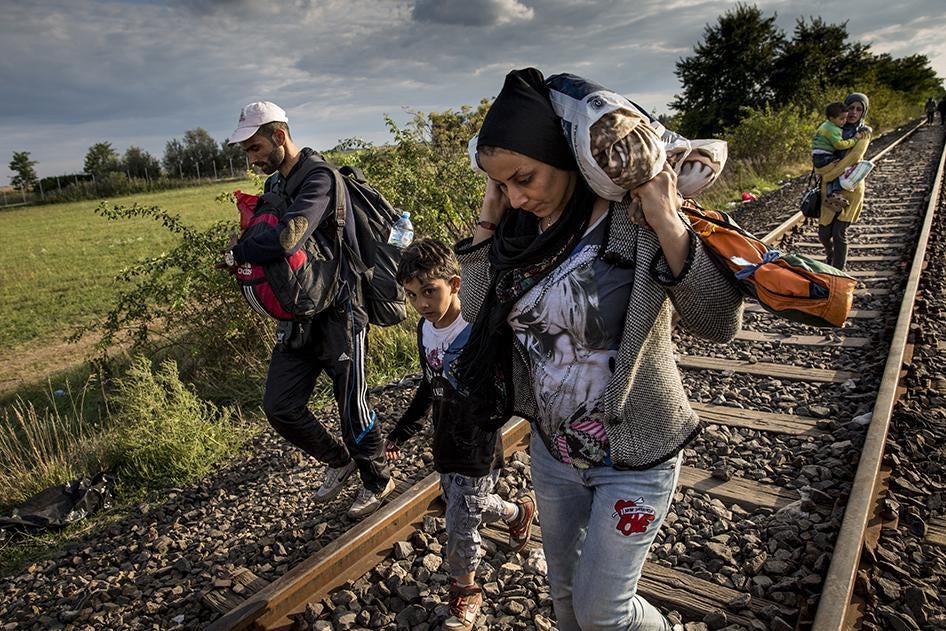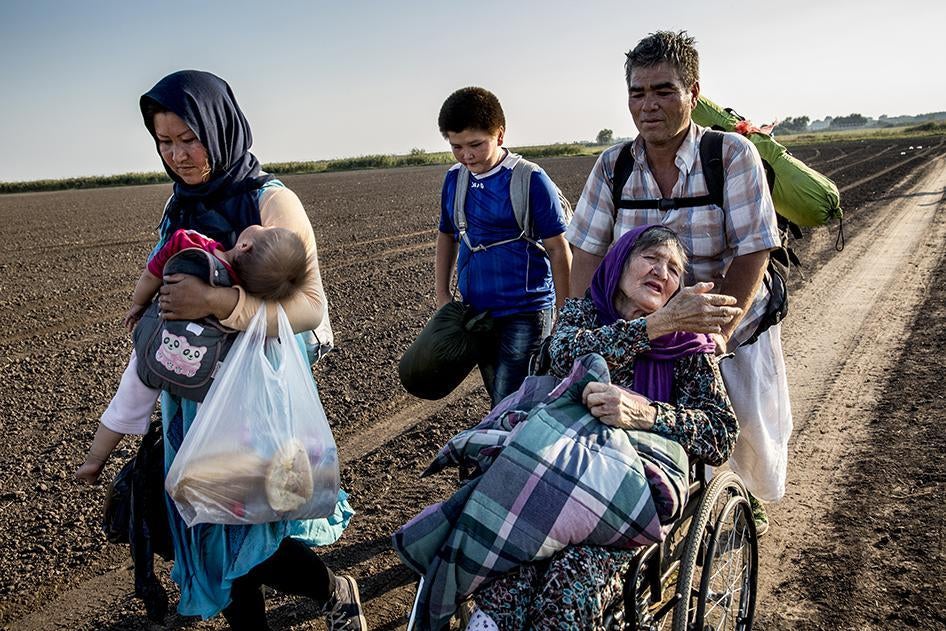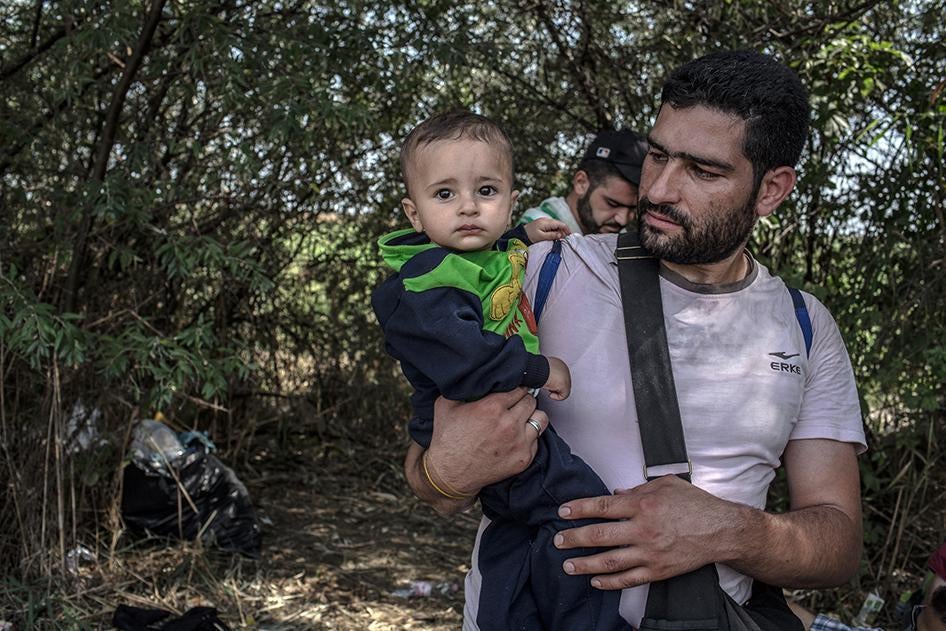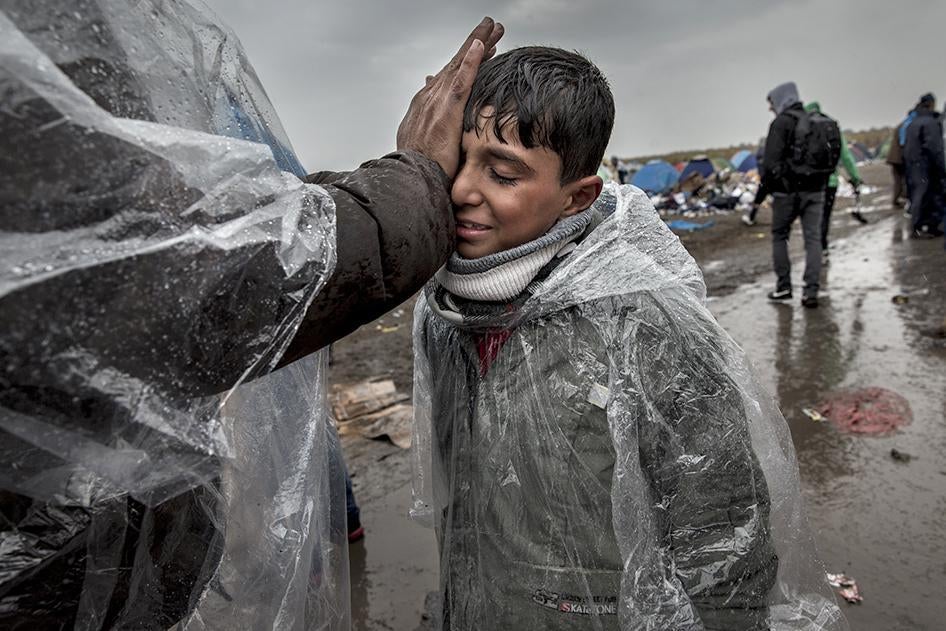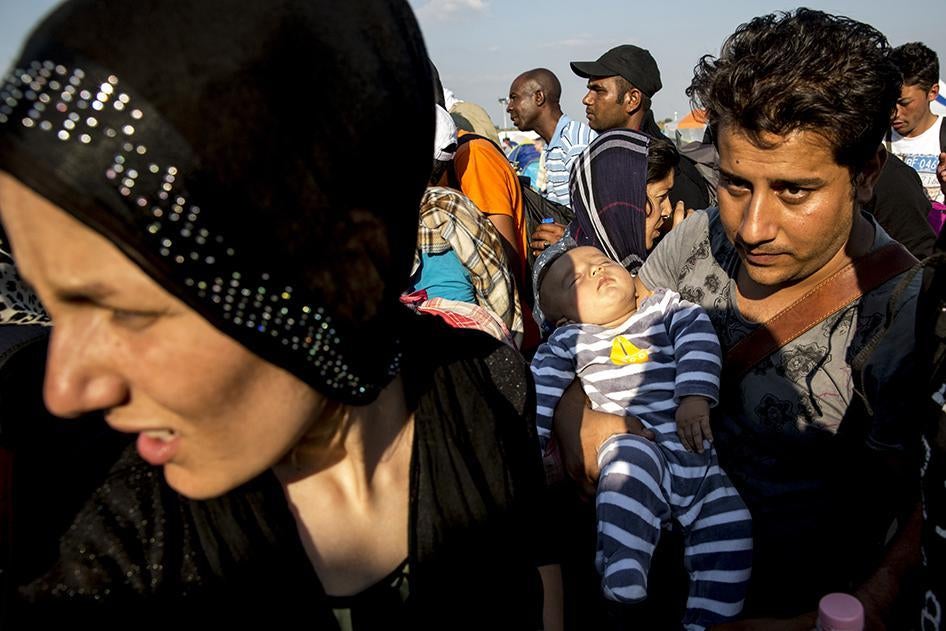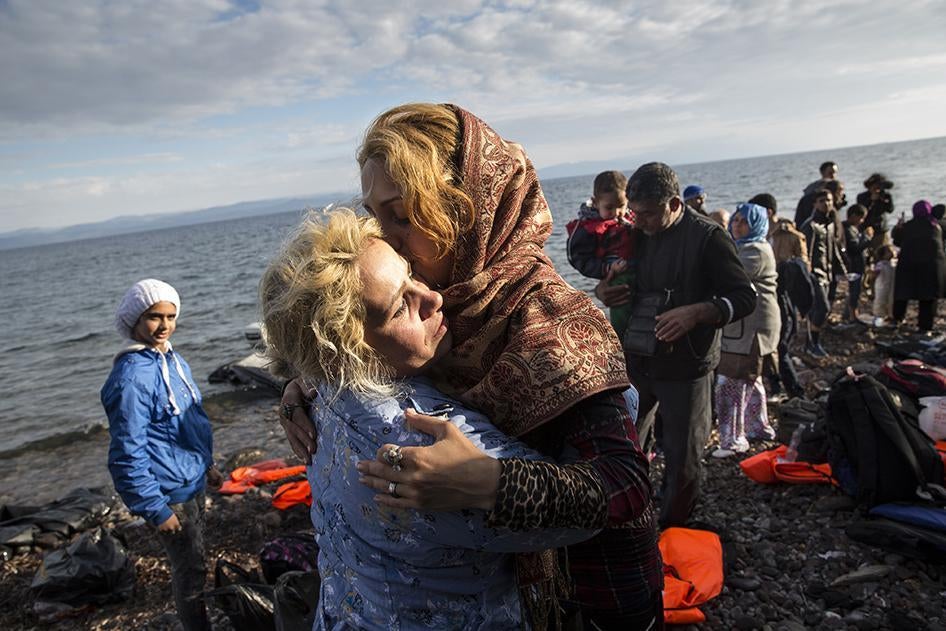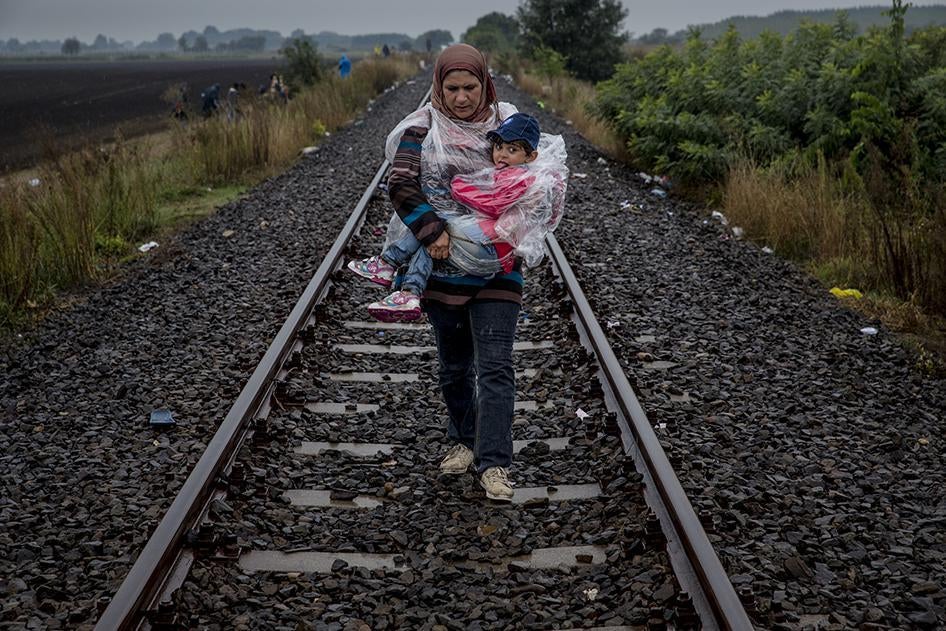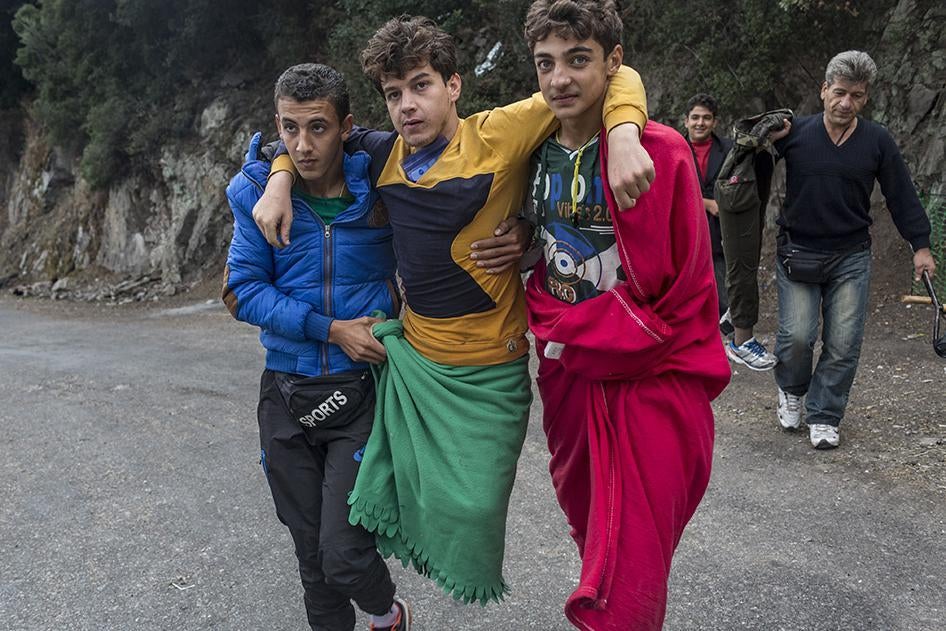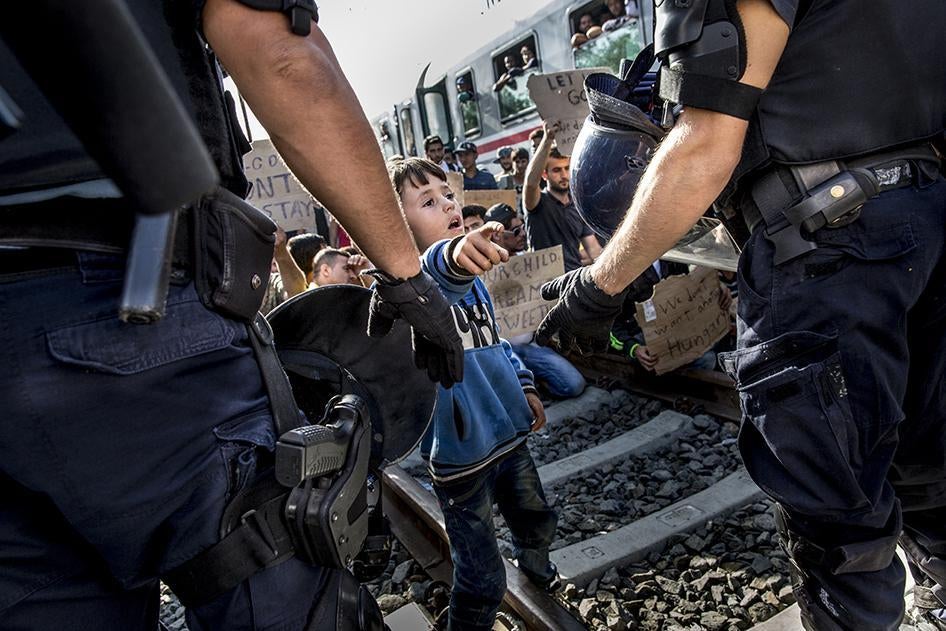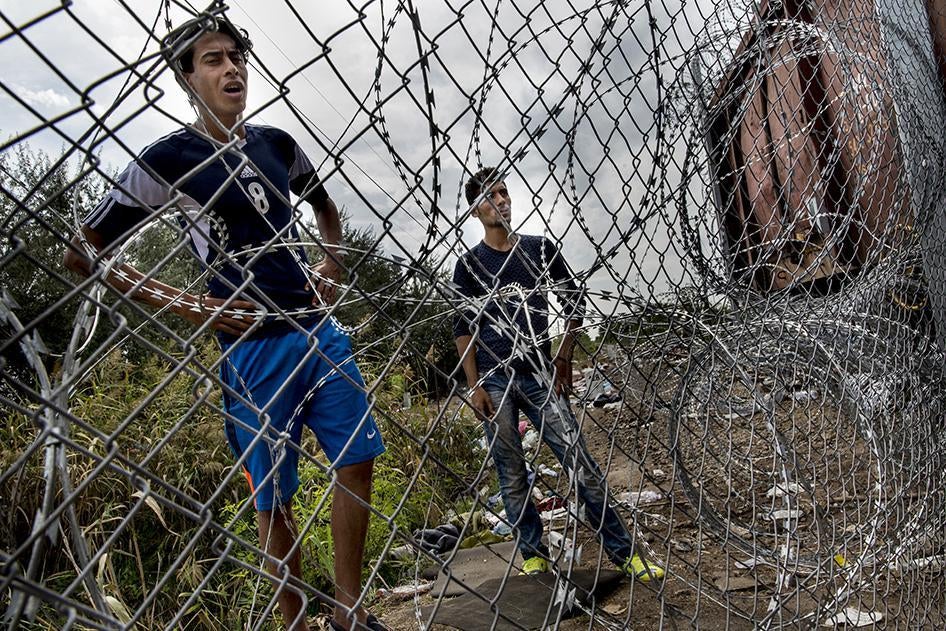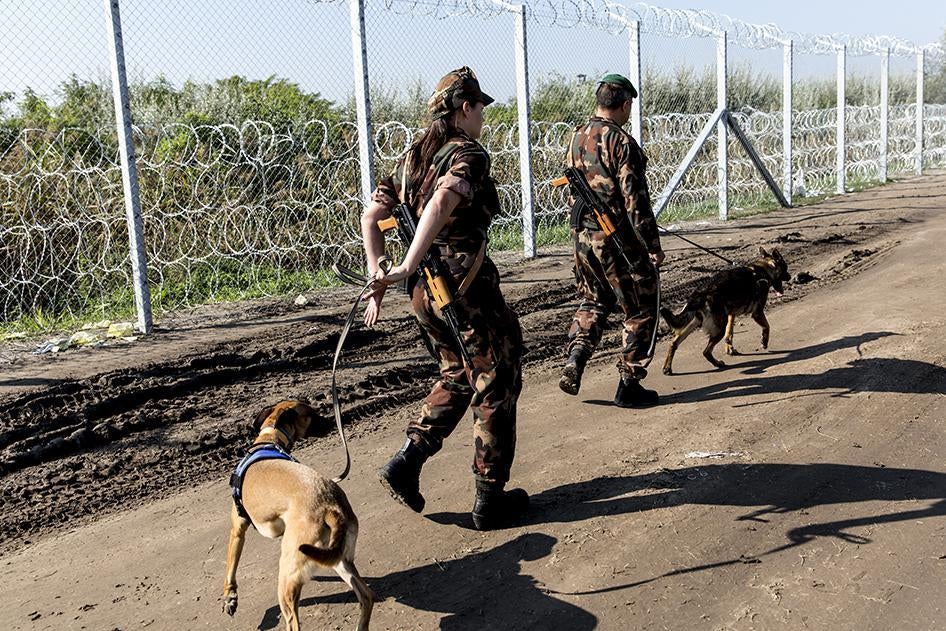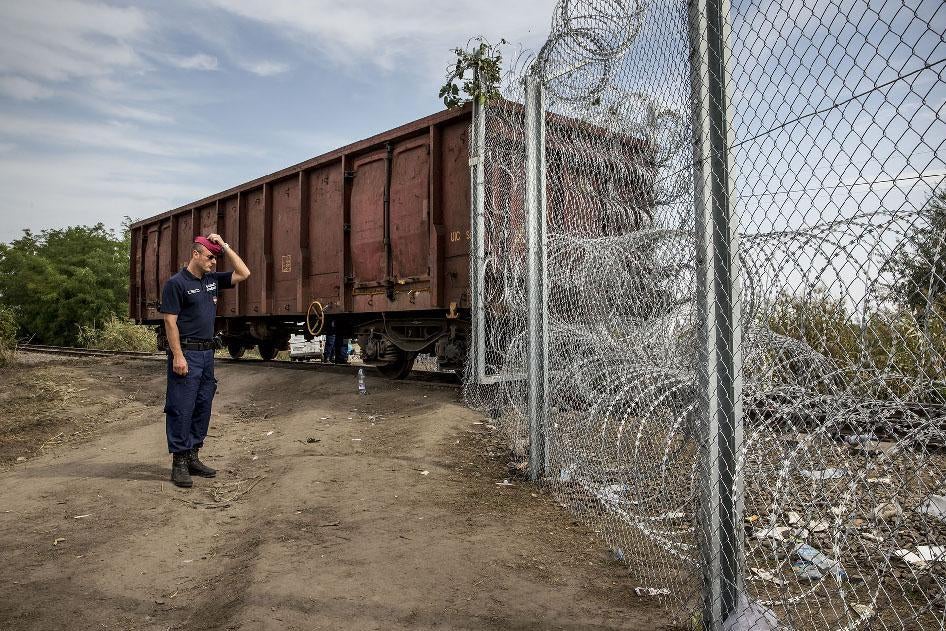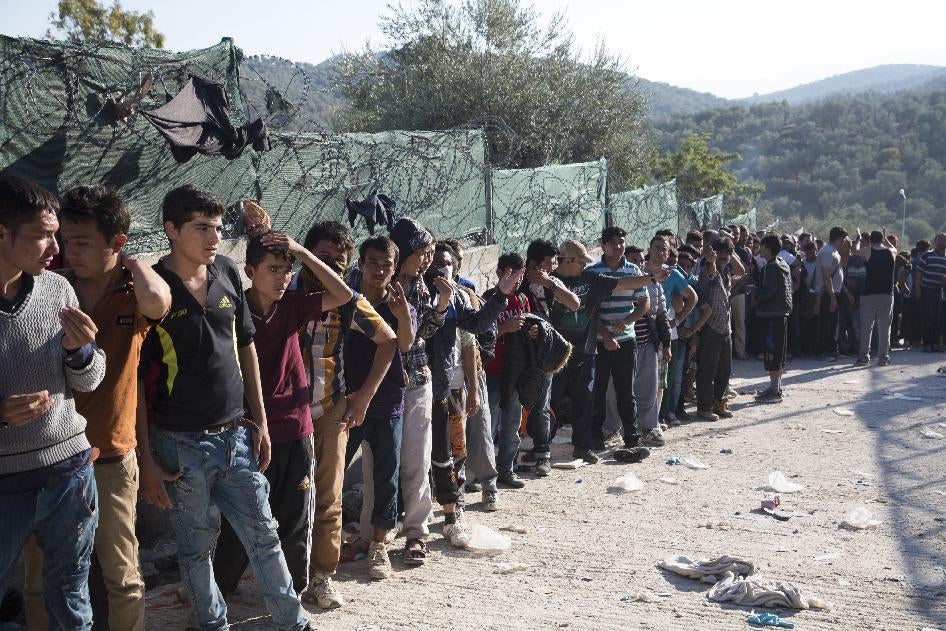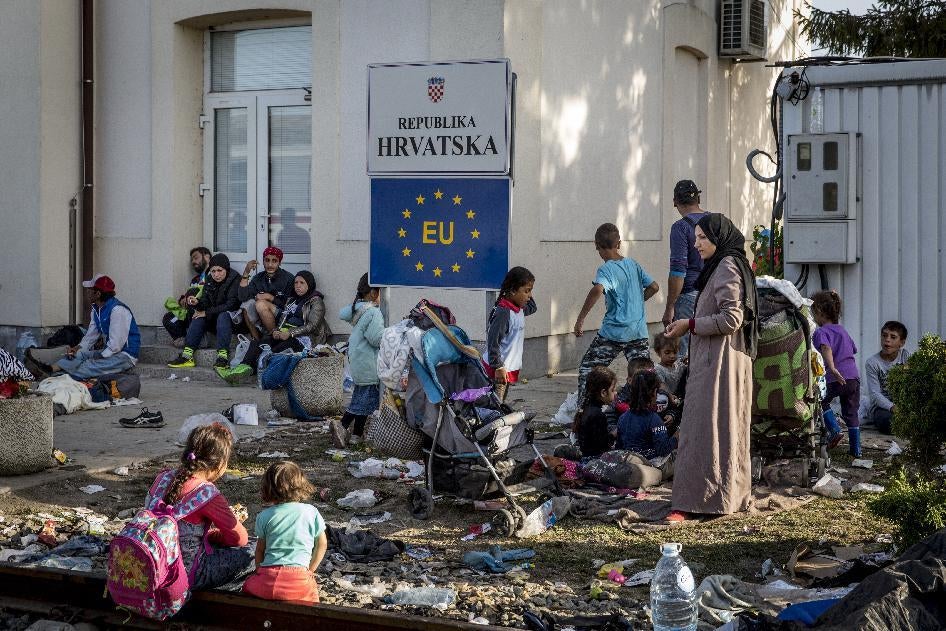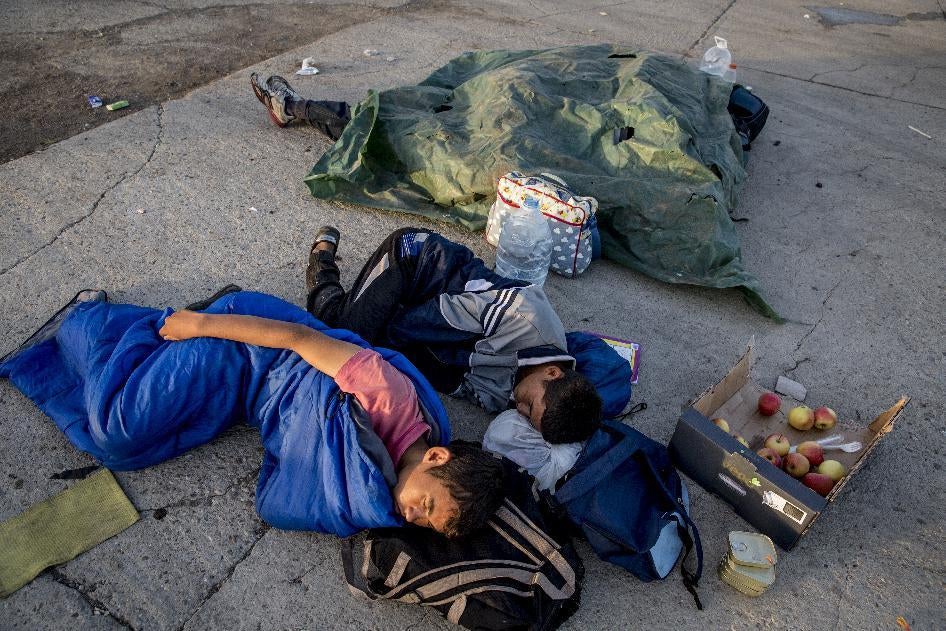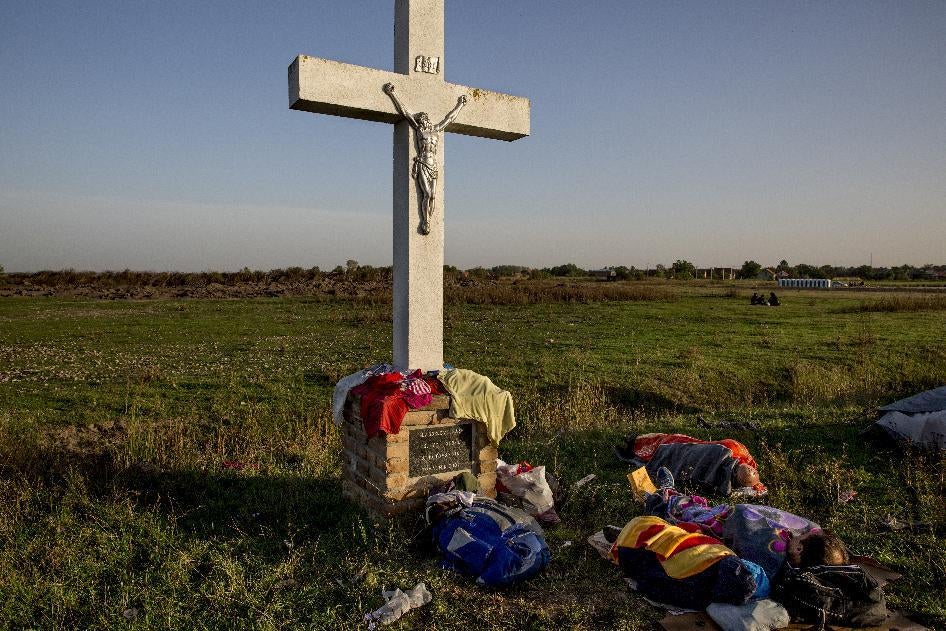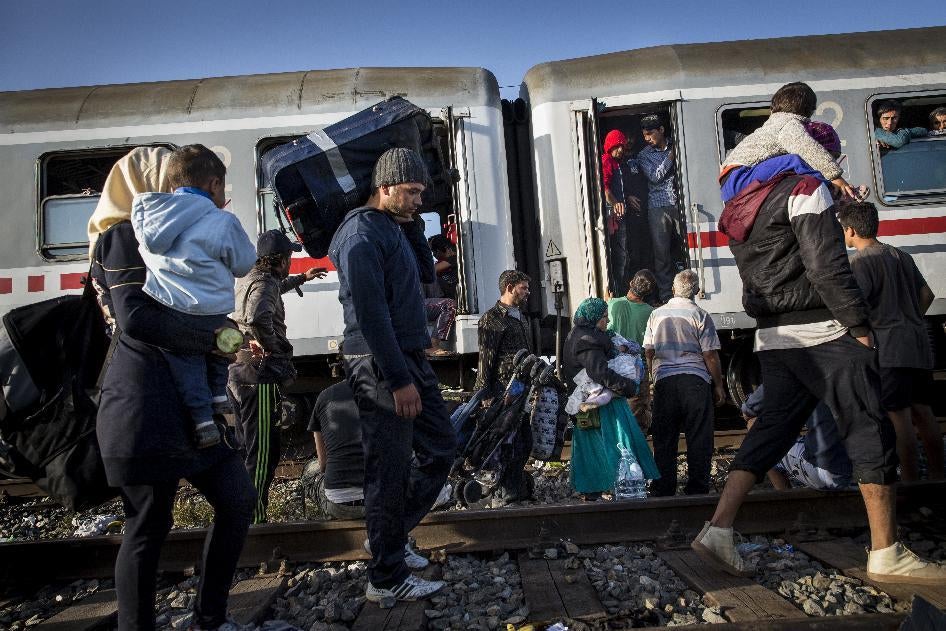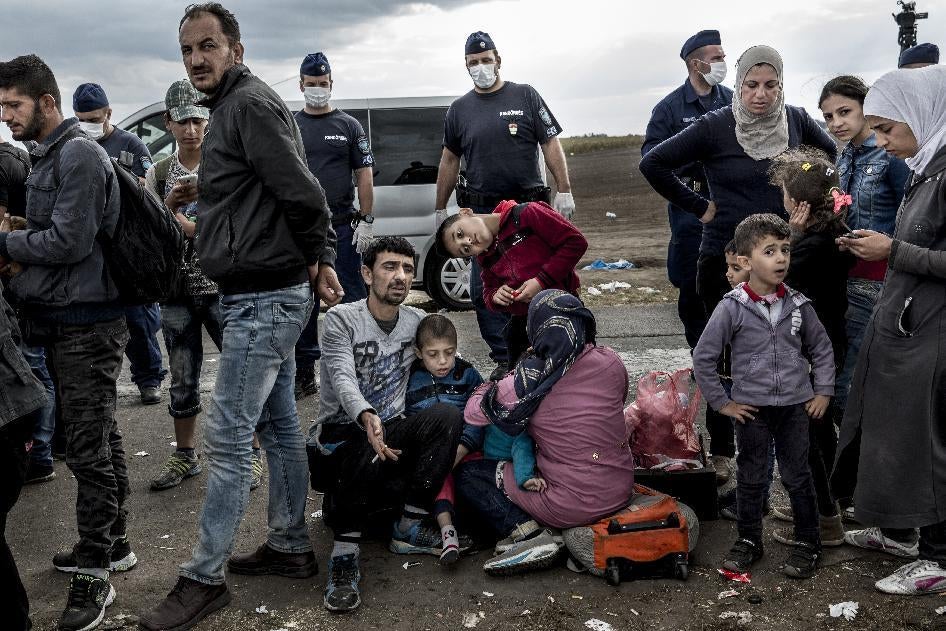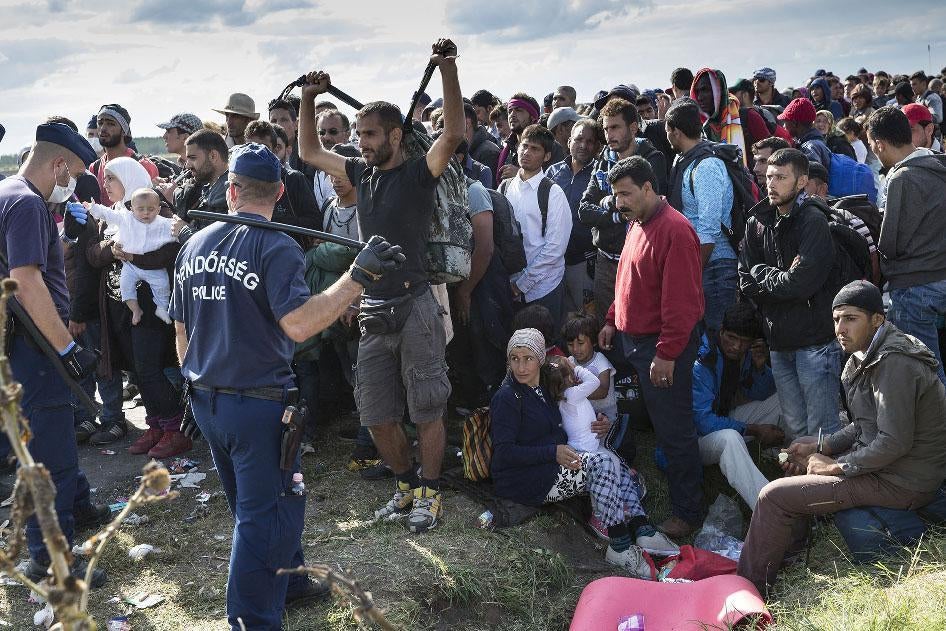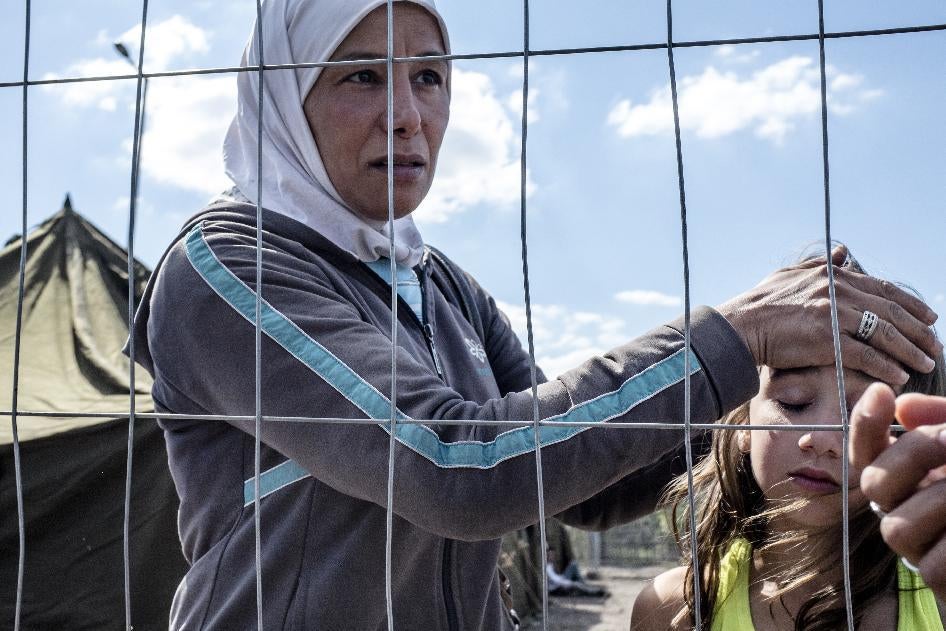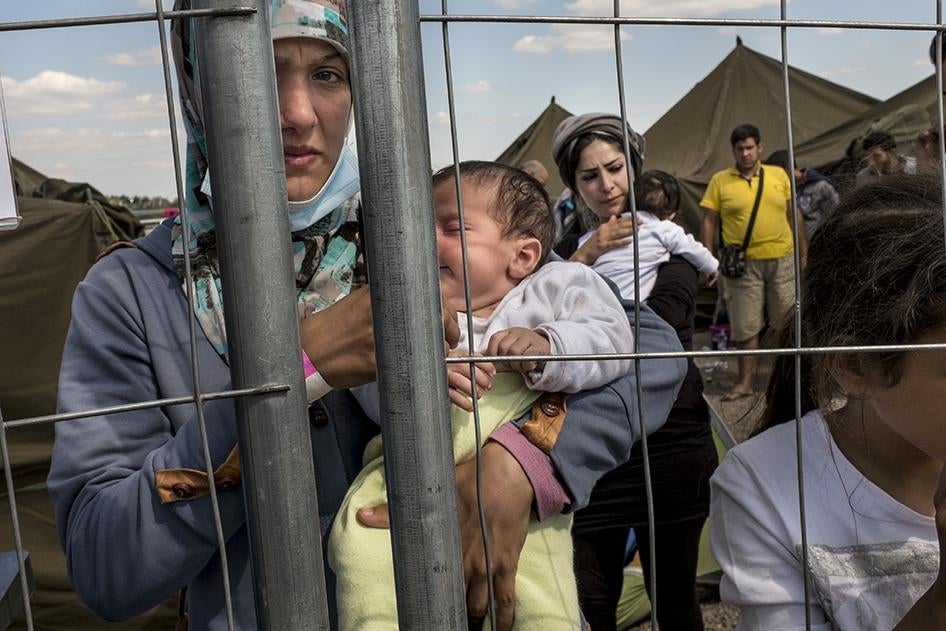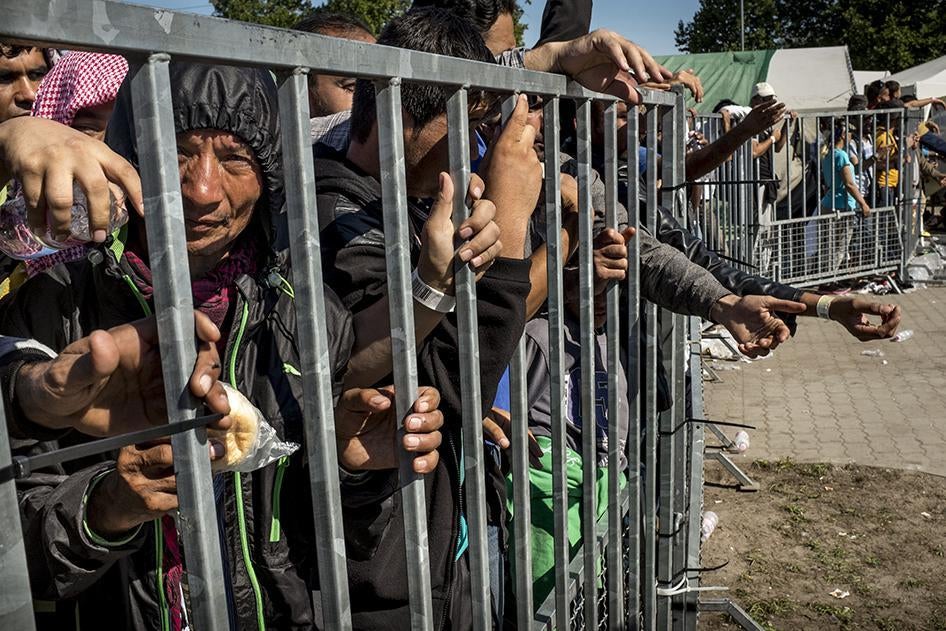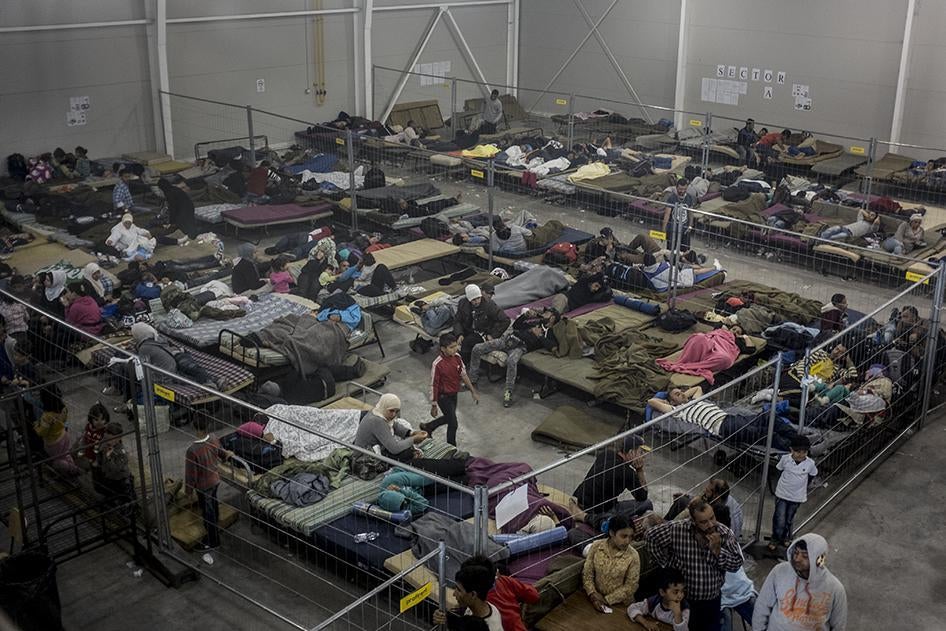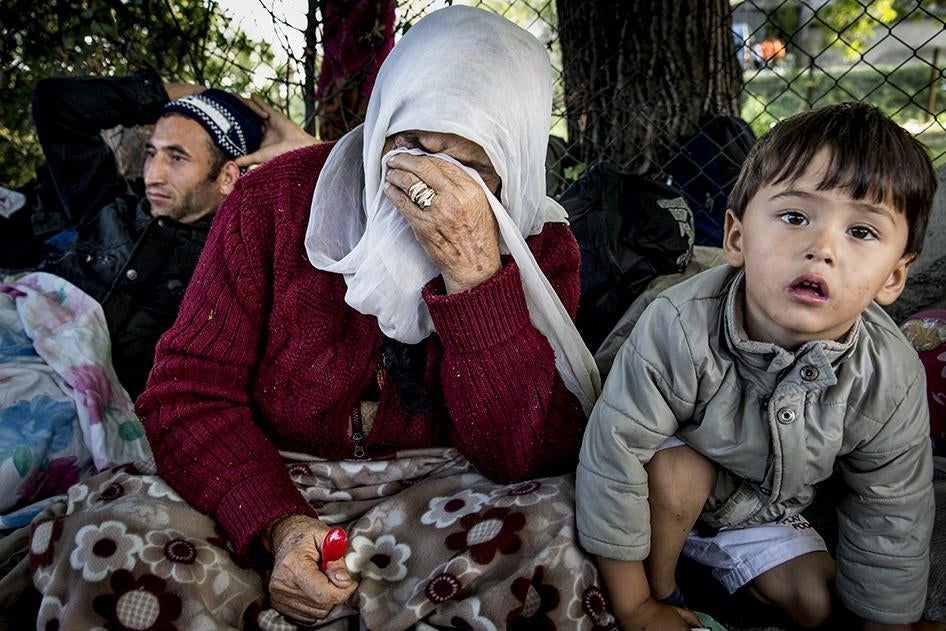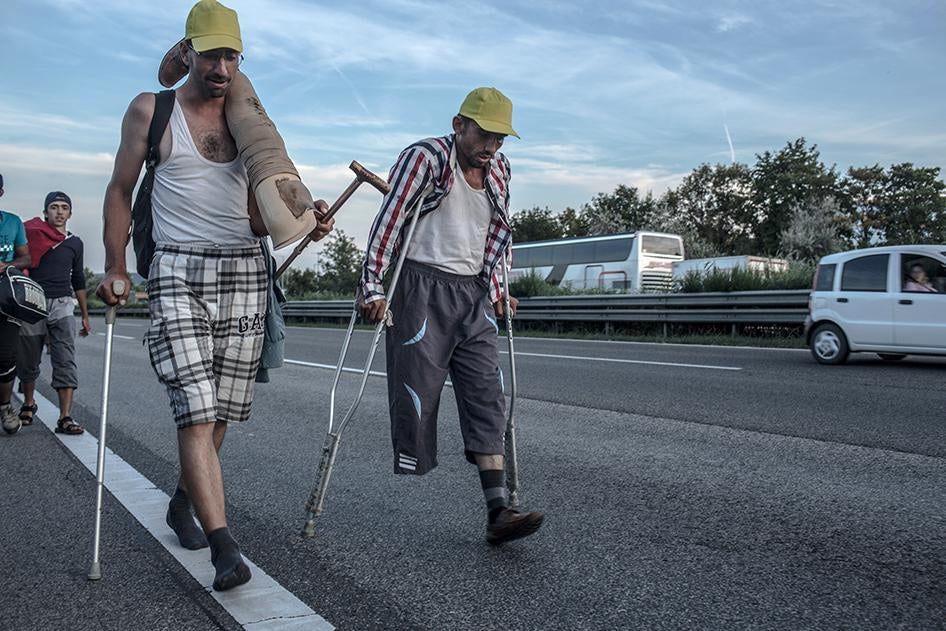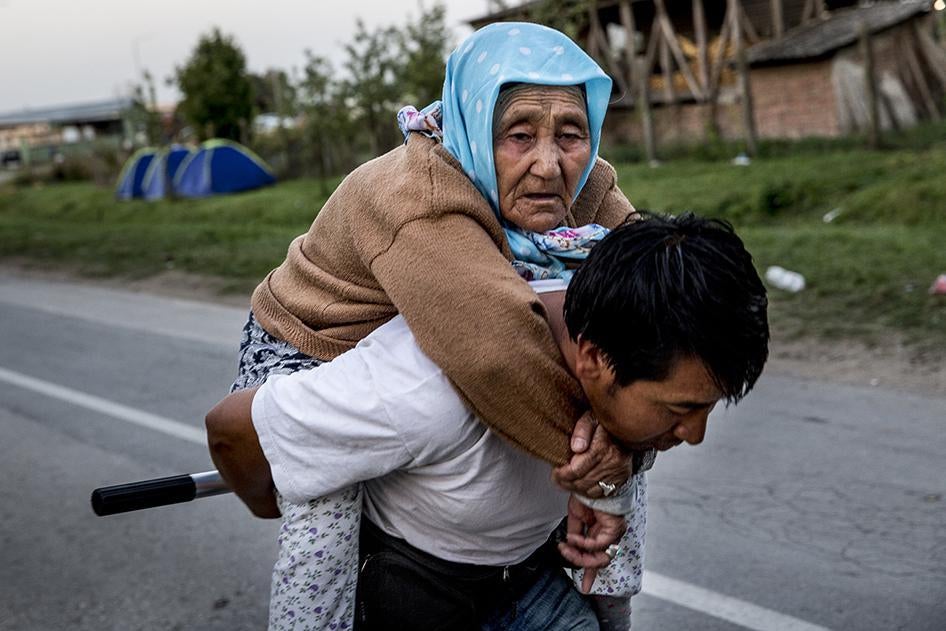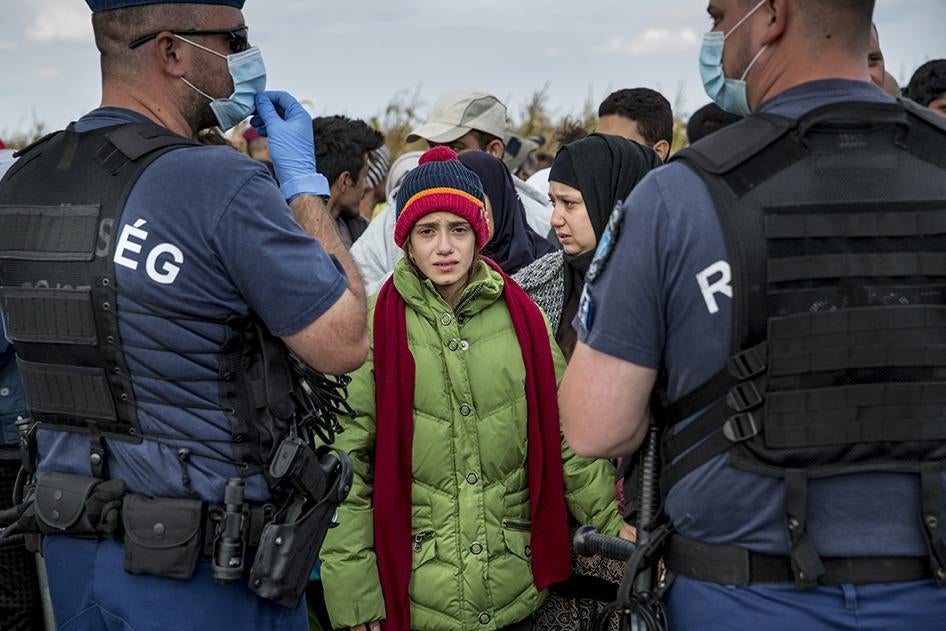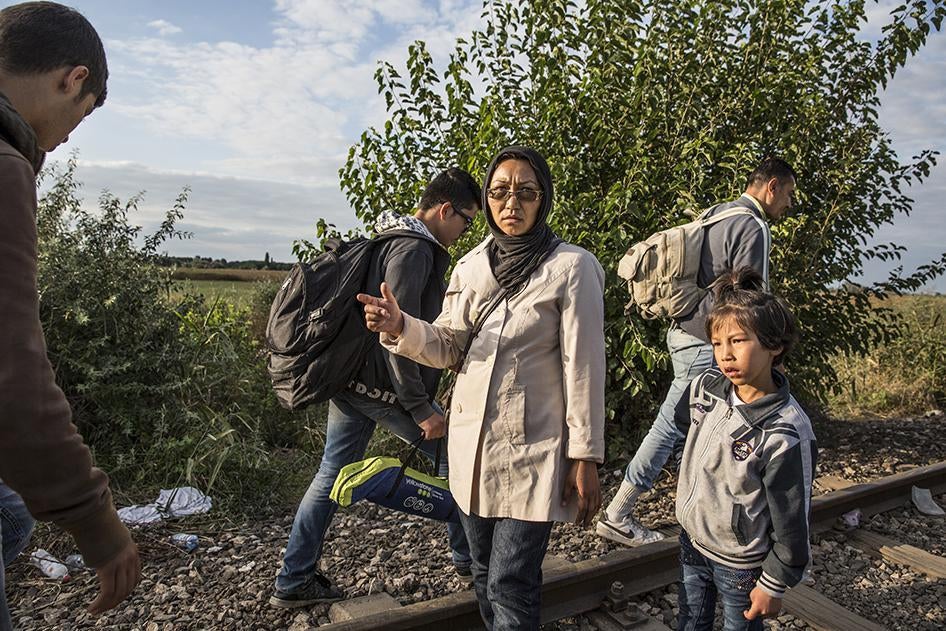Introduction
Unprecedented numbers of migrants and asylum seekers traveled by sea to European shores in 2015. By mid-November, over 800,000 had reached Italy and Greece, with relatively small numbers arriving in Spain and Malta. According to UNHCR, the UN refugee agency, 84 percent originate from Syria, Afghanistan, Eritrea, Somalia, and Iraq—all countries experiencing conflict, widespread violence and insecurity, or highly repressive governments. Even accounting for misrepresentations of nationality and the presence of migrants seeking to improve their lives, this should be understood broadly as a refugee crisis.
EU governments, largely acting on proposals from the European Commission, the EU’s executive body, are taking or have pledged to take a number of laudable steps to address various aspects of the refugee crisis. However, after some efforts to increase the focus on migrants and asylum seekers inside the EU, the focus of many EU governments now appears to have shifted decisively back to a default position—namely efforts aimed at preventing or discouraging people from attempting to reach EU territory, tackling smuggling networks, and rapidly deporting individuals who do not have a right to remain in the EU.
Implementing effective border and migration controls and helping vulnerable people avoid hazardous journeys, of course, are legitimate goals if safe and orderly alternatives are provided to people seeking international protection. But EU governments must also ensure that Europe’s response to this crisis matches its legal responsibilities and stated values. In a world characterized by rising displacement, conflict, and human rights abuse, EU leadership is more important than ever.
Together, EU governments should do much more to ensure access to effective protection, including on EU territory, and guarantee respect for the rights of asylum seekers and migrants at EU borders and on EU territory. This document sets out key principles that we believe should guide EU and EU member state action going forward.
Human Rights Watch recommends action by the European Union and its member states in four broad areas: (1) reducing the need for dangerous journeys; (2) addressing the crisis at Europe’s borders; (3) fixing the EU’s broken asylum system; and (4) ensuring that EU cooperation with other countries improves refugee protection and respect for human rights.
Specifically the EU and member states should:
- Save lives at sea through sustained search and rescue operations along the main migration routes in the Mediterranean.
- Ensure that passengers on all vessels interdicted at sea that are suspected of being used for human trafficking or smuggling are disembarked at a safe location in EU territory. Vessels should not be diverted or returned to a place where passengers might be exposed to the risk of persecution, torture, or inhuman and degrading treatment, to the risk of harm from indiscriminate violence, or to the risk of chain refoulement.
- Ensure that action against smugglers and traffickers who endanger lives respects human rights, guarantees the ability of asylum seekers to seek international protection in other countries, and does not itself put passengers’ lives in danger.
- Ensure that EU anti-smuggling efforts in the Mediterranean do not leave asylum seekers in Libya with no access to protection.
- Increase safe and legal channels into the EU to reduce demand for smuggling and dangerous journeys, specifically through:
- Increased refugee resettlement;
- Expanded family reunification;
- Reform of the EU Visa Code with a view to creating a Schengen humanitarian visa;
- Address the crisis at Europe’s borders, including by:
- Ensuring access to a fair and efficient asylum procedure, as required by EU law;
- Guaranteeing adequate reception conditions, as required by EU law, with special attention to groups with particular needs such as unaccompanied children, people with disabilities, women, the elderly, and the ill;
- Improving emergency preparedness and coordination and enhancing the capacity of the EU civil protection mechanism;
- Ensuring that the emergency relocation plan to benefit 160,000 asylum seekers is implemented swiftly and expanded as needed;
- Ensuring that the new asylum “hotspots” respect asylum seekers’ and migrants’ rights, including the right to an effective remedy; humane returns; and limitations on the resort to and length of detention;
- Ensuring that any measures to streamline asylum applications to prevent or address backlogs and delays do not undermine due process rights;
- Ensuring proper screening and referrals to services for asylum seekers facing protection risks, including gender-based violence and trafficking;
- Agreeing to a permanent relocation mechanism to more equitably apportion state responsibility for examining asylum claims based on rational and transparent criteria.
- Fix the EU’s broken asylum system, including through:
- Strict enforcement of EU asylum laws by the European Commission through more frequent infringement proceedings and litigation before the EU Court of Justice;
- Increased support from the European Asylum Support Office and the European Refugee Fund to underperforming member states;
- Replacement of the Dublin Regulation with a more equitable and permanent mechanism for determining the member state responsible for examining any particular application for international protection. Determinations should be based on rational criteria that take into consideration the capacity of member states and, to the extent possible, the wishes of the applicant.
- Ensure that any efforts to “externalize” migration management do not worsen access to protection and respect for human rights, including by:
- Recognizing that EU efforts to build capacity in non-EU countries to fairly process and humanely host asylum seekers are long-term efforts that are a complement to EU efforts within its own borders, not a substitute for full compliance with international and EU law;
- Designing, implementing, and monitoring EU immigration cooperation with third countries to ensure this cooperation does not trap people in abusive situations, prevent them from accessing fair asylum procedures, or lead to refoulement to places where they would be at risk of persecution or inhuman or degrading treatment;
- Using EU and individual member states’ influence and resources more effectively to address the major drivers of migration, including through promotion of human rights in countries of origin.
- Ensuring that programs developed with security forces and other government agencies in countries of origin do not contribute to human rights violations.
I. Reduce the Need for Dangerous Journeys
The hope of more freedom, security, and prosperity is often intertwined with the need to escape persecution, war, and human rights abuses. In this way, both pull and push factors are in play when people are on the move. People are willing to take enormous risks to escape conflict, persecution, and human rights abuses or to improve their lives and those of their loved ones. Insofar as more freedoms, liberties, and policies grounded in respect for human rights—including vital rescue-at-sea operations—serve as pull factors, these should not be sacrificed in the name of limiting migration.
Save Lives at Sea
The Mediterranean is the world’s deadliest migration route. According to the International Organization for Migration (IOM), over 3,455 people died at sea trying to reach the EU as of November 10, 2015. This surpasses the 3,149 who died in all of 2014, and includes an increase in deaths in the Aegean Sea as it became the principal sea channel into the EU. The IOM recorded 512 deaths in the Aegean Sea, up from 73 the previous year.
Exposing boat migrants to the risk of drowning can never be an acceptable form of border control. The acceptable approach lies in providing access to safe crossing options and effective search and rescue operations, with all those rescued brought to EU territory for fair processing of any claims for international protection, and with appropriate humane and dignified returns of those who do not have a valid basis to remain in the EU.
Stepped-up search and rescue operations, including by humanitarian and private organizations, have made a difference. These efforts have been concentrated in the central Mediterranean, traditionally the most used, and deadliest, route. Following the deaths of over 1,000 people in a single week in April 2015, the EU tripled the budget of Frontex, its external borders agency, for operations in the Mediterranean. Importantly, it extended the operational plan of its Operation Triton, in the central Mediterranean, to patrol and perform search and rescue in international waters adjacent to Libyan territorial waters. The budget for Operation Poseidon, in the Aegean Sea (eastern Mediterranean) between Turkey and Greece was also increased, but remains much smaller. On October 25, EU governments and the European Commission agreed to scale up Operation Poseidon. All EU governments should implement this decision and deploy financial, material, and human resources as quickly as possible.
Counter Illegal Smuggling and Trafficking While Upholding Migrants’ and Asylum Seekers’ Rights
There can be no doubt that many smugglers and all traffickers abuse migrants and asylum seekers along migration routes into the EU. International law makes a distinction between smugglers—who profit from helping willing clients without valid entry documents—and traffickers—who move people against their will or by deceiving them, and exploit them.
Abuses include holding individuals hostage for months in grueling, violent conditions until relatives transfer money to traffickers; beatings with wooden sticks and iron pipes, rubber hoses, and whips; shooting attempted escapees; forced labor; and detention before departure for Europe in unsanitary, overcrowded smuggler-run “safe houses,” particularly in Libya. Smugglers routinely overload unseaworthy boats; provide insufficient food, water, and fuel for the journey; and lock women, men and children below deck, putting their lives at grave risk in the event of a shipwreck.
While governments arrest and prosecute traffickers and smugglers for their crimes, all law enforcement action taken against smugglers, to whom many migrants and asylum seekers turn knowingly to facilitate their journeys, should comport with international law, and above all ensure the lives and safety of migrants and asylum seekers. It is also vital that any action against smugglers is coupled with efforts to increase safe and legal routes for asylum seekers and migrants. Without efforts to reduce demand, reducing supply is likely only to increase prices, thereby encouraging others to enter the illegal trade. Likewise, law enforcement action taken against traffickers should ensure protection for victims, who are often traumatized and vulnerable; relevant measures should include provision of medical, psychosocial, and other care, and, in appropriate cases, issuance of humanitarian visas for trafficking victims and witnesses.
The EU naval operation in the Mediterranean targeting smuggling networks, initially named EUNAVFOR MED and recently dubbed Operation Sophia, began with surveillance and intelligence-gathering. In October 2015, it entered into its second phase, involving a military operation to board, search, seize, and divert migrant boats in international waters. Military interdiction and diversion operations that are not predicated on rescue at sea run the risk that migrant vessels will be diverted on the high seas in ways that expose their passengers to unsafe conditions or to human rights abuses, or that prevent asylum seekers among them from seeking effective international protection, exposing them to the risk of refoulement.
The European Commission and Council should also carefully assess whether this interdiction and diversion policy will push both smugglers and migrants to take even more risks and increase the dangers of boat migration in the Mediterranean. The Commission and Council should also assess the risk of trapping migrants and asylum seekers in Libya, where they are often subjected to violence and abuse and have no possibility to lodge asylum claims. Any operations conducted by EU vessels are subject to the jurisdiction of the European Convention on Human Rights, which requires designing, planning, and implementing all operations with full respect for rights. These include the rights to life, liberty, and security, as well as an effective remedy for violations and the prohibition of torture. The prohibition on torture includes a ban on sending anyone to a country where they risk torture or cruel, inhuman, or degrading treatment or threats to their lives or freedoms—the nonrefoulement principle.
Migrants intercepted by EU vessels in the Mediterranean, including by vessels participating in EUNAVFOR MED, should be taken to safe ports in the EU, where those asking for protection or indicating a fear of return should undergo asylum screening.
Provide Safe and Legal Channels
Preventing dangerous methods of migration is a stated, and laudable, goal of EU policies. Most of the policy options endorsed by EU governments focus on preventing departures and limiting arrivals, through dissuasion, externalization of asylum responsibilities, and addressing root causes. The human rights implications of these policies are discussed below. Much of the policy debate is guided by a concern about creating so-called pull factors—incentives for people to attempt to reach the EU. According to UNHCR, 84 percent of the over 800,000 people who reached Europe by sea between January and mid-November 2015 were from five refugee-producing countries: Syria, Afghanistan, Iraq, Eritrea, and Somalia. This underscores that push factors—the myriad rights abuses and hardships people face in their home countries—are key drivers for many of those arriving in Europe today.
The thousands of recent deaths in the Mediterranean are a tragic testament to the risks people will take, without any guarantee of rescue or refuge, to escape war, persecution, and poverty. The risk of death along perilous migration routes is unlikely to deter people fleeing conflict or persecution, nor can it in good conscience serve as a policy option. Respecting the human rights of migrants and asylum seekers is not a choice: it is an obligation, even if the promise of decent treatment and the hope of a better life serve as additional motivators.
The provision of more safe and legal channels into the EU—ways for migrants, asylum seekers, and refugees to reach EU territory without having to risk their lives or resort to criminal networks—could reduce the use of dangerous migration avenues. The development of such channels need not amount to an open door policy: those arriving can be screened, have their protection needs assessed, and their entitlement to remain in the European Union determined based on their international protection needs and any human rights imperatives. Those found, after a fair procedure, not to have such a basis to remain could be removed.
Here are four steps we believe the EU should take to increase safe and legal routes:
Increase Refugee Resettlement
According to UNHCR, there are over 60 million refugees, asylum seekers, and internally displaced people in the world today. In May 2015, the European Commission called on EU member states to participate in an EU-wide resettlement program to help 20,000 recognized refugees in other regions find new homes in Europe over the next two years. The response was positive, with EU governments, plus Iceland, Liechtenstein, Norway, and Switzerland, pledging to take in over 22,500 refugees through UNHCR-coordinated programs, a marked increase over the EU’s previous resettlement commitments. Additional significant national pledges by Germany and the United Kingdom are also noteworthy. However, these efforts remain insufficient given the scale of the global refugee crisis.
Syria has produced over four million refugees, the vast majority of them in Turkey, Lebanon, and Jordan. UNHCR estimates that in 2015, globally, 960,000 people were in need of resettlement, including 316,000 in the Middle East and 279,000 in Africa.
Despite this need, however, UNHCR has set a target of about 127,000 resettlement referrals for 2015 and says it has the staff capacity to process only about 70,000. If donor governments provide UNHCR more resources for resettlement, and all countries with the capacity to resettle refugees do their fair share, 127,000 would be a manageable number.
For too long the EU has been on the resettlement sidelines. The EU’s current pledge to resettle 22,000 over the next two years is insufficient. It can and should do more, and more quickly. Resettlement should be regarded as a supplement to asylum, not a substitute.
Facilitate Family Reunification
EU-wide rules on family reunification, which provide more favorable benefits for refugees than for persons granted subsidiary protection or foreign residents, are based on a narrow concept of the family unit (primarily limited to spouse and minor children).
UNHCR has identified this limited family definition— which can exclude underage siblings, common law (or customary) spouses, and extended family relatives who have de facto become part of the family unit—as among the obstacles refugees face to family reunification in the EU. While EU countries may adopt more lenient policies, few do. Other obstacles identified by UNHCR include insufficient information about the procedure, the limited time frame for applying for family reunification, and difficulties documenting family links and dependency.
Another problem is the backlog in processing asylum claims; until an asylum seeker is recognized as a refugee, he or she is not able to petition for family reunification. Such delays can cause extreme anxiety both for the refugee and for family members left behind, and can lead the latter to embark on unsafe journeys. Authorities should consider expediting the asylum procedure for asylum seekers who indicate a strong desire for family reunification and ask for expedited review.
The European Commission has encouraged member states to apply their discretion to increase, rather than limit, access to family reunification. For example, the Commission has called on states to afford the same possibilities to those benefitting from subsidiary protection as to recognized refugees, and to use their discretion “in the most humanitarian way” to allow family reunification for extended family members “if they are dependent on the refugee” (including by taking into account legal, financial, emotional or material support). This approach, if implemented across the EU, could help reunite families and reduce the number of people, including children, risking their lives to reach Europe.
Provide Humanitarian and Other Visas
Humanitarian visas are an underutilized tool for helping eligible individuals reach the EU without risking their lives or resorting to smugglers. These limited-term visas can be issued in embassies and consulates to individuals seeking to apply for asylum and to other individuals on humanitarian grounds. According to a 2014 study by the European Parliament (EP), 16 EU member states currently have or once had national schemes for issuing some kind of humanitarian visa, but they have used the schemes sparingly.
The EU Visa Code provides for the granting of humanitarian visas to persons in situations of vulnerability without the onerous requirements attached to other kinds of visas. There is, however, no EU-wide scheme, based on common guidelines and procedures, for issuing these visas, and the provisions in the EU Visa Code are ambiguous. The EP study cited above concluded that EU member states have an obligation under the existing code to issue humanitarian visas “when this follows from their refugee and human rights obligations,” but also that the code needs to be reformed to better guarantee effective use of such visas. In particular, the EP study recommended the creation of an independent formal procedure with a right of appeal; consideration of granting uniform visas valid in the entire Schengen Area (not limited to one or a few member states); and a mechanism for monitoring the issuance of such visas, including the collection of statistics.
The European Parliament called on EU member states to “make full use of existing possibilities” for granting humanitarian visas in an April 2015 resolution, and is currently examining possible reforms to the EU Visa Code, based on a European Commission proposal from 2014. The Parliament, Commission, and Council should agree on a revised code that clarifies policies and procedures, harmonized across the EU, for issuing humanitarian visas to people in need of international protection, particularly in emergency situations where a person needs to be evacuated quickly and cannot wait for slower refugee resettlement processing. The reform should also make the visas available for other compelling humanitarian reasons, such as medical interventions that are unavailable in countries of origin or asylum.
Expand Avenues for Legal Labor and Educational Migration
Not all of those arriving on European shores are asylum seekers. Particularly along the central Mediterranean route, these are mixed flows and include people seeking improved economic and life prospects for themselves and their families. Many may be escaping poverty, corruption, and bad governance, or simply doing what they feel is necessary to live a freer and more dignified life. Under current international refugee law and EU directives, they are unlikely to qualify for international or any other kind of protection.
In its European Agenda on Migration, the European Commission asserts the EU’s need for new policies on legal migration, citing Europe’s aging population and migration as “an important way to enhance the sustainability of our welfare system and to ensure sustainable growth of the EU economy.” As the Commission and member states take forward proposals for review of existing avenues for legal migration and the creation of new ones, it will be important to explore a variety of options, including employment visas for workers at all skill levels and student visas.
II. Address the Crisis at Europe’s Borders
The significant influx of asylum seekers and migrants has created dramatic situations at various EU borders over the past several months. Daily arrivals, for months on end, of thousands of people on Greek islands created an enduring humanitarian crisis. Many who reached Greece by sea eventually continued their journey overland through the Western Balkans, encountering police abuse in Hungary, Serbia, and the former Yugoslav Republic of Macedonia (hereafter Macedonia) and unacceptable detention conditions in Hungary, Macedonia, and Greece. Hungary’s abusive new approach—criminalizing irregular entry for asylum seekers, and virtually sealing its border with Serbia—caused a shift in routes for those trying to reach Germany, leading to cascading border closures and chaotic, sometimes violent, scenes at border crossings.
To address these problems, the EU should:
Ensure access to asylum procedures
EU member states have an obligation under EU law to guarantee an effective right to seek asylum. This right is enshrined in the EU Charter of Fundamental Rights, and given practical effect in various EU laws and regulations. This obligation trumps other obligations, such as the onus on countries on the EU’s external borders to ensure border security. EU laws do not require border countries to build fences, nor do they prohibit the building of fences. However, EU law does impose a clear obligation on all member states to guarantee access to a fair and efficient asylum procedure, including at borders. Insofar as fences, such as those around Spain’s enclaves in North Africa (Ceuta and Melilla), at the Hungary-Serbia border, the Bulgaria-Turkey border, and the Greece-Turkey border effectively prevent individuals from accessing formal procedures, they result in violations of states’ obligations.
Border enforcement measures by countries neighboring the EU, such as Turkey, that effectively prevent undocumented asylum seekers from exiting and reaching official EU border crossing posts are also problematic. Fences and other measures to seal land borders, including pushbacks, may also contribute to people resorting to more dangerous migration routes such as swimming rivers or taking risky sea journeys. While accelerated procedures to assess claimants are permitted at border crossings, these must comport with fundamental guarantees, including a meaningful right to appeal and adequate measures for identifying protection risks, including gender-based violence or trafficking.
Guarantee adequate reception capacities at EU borders
Frontline states such as Italy, Greece, Hungary, and increasingly Croatia, Slovenia, Austria, and Germany, have prepared poorly for the influx. Throughout 2015, arriving asylum seekers and migrants found themselves in chaotic and inhospitable scenes at EU borders.
Greece, which has seen hundreds of thousands of people arriving on its islands, is ill-equipped to provide for even the most basic needs of shelter, food, water, and medical care, or adequate security. The vacuum left by the state has been filled to a certain extent by humanitarian organizations and volunteer groups, both Greek and international, operating on the beaches of first arrival and running informal camps. The situation on Lesbos, the island that receives the highest numbers—an average of 4,000 to 5,000 per day over the last few months—is especially worrisome, but smaller islands like Kos and Leros lack even the basic infrastructure necessary to provide first reception. The situation is dire for everyone, while persons with particular needs, such as pregnant women, women heads of household, unaccompanied children and persons with disabilities face unique challenges without appropriate, consistent measures in place to address their needs.
The European Commission has allocated millions of euros in humanitarian aid to Serbia, Croatia, Macedonia, and most recently Slovenia, through the EU Civil Protection Mechanism, a disaster relief program. It has also earmarked over €50 million in emergency funding to Austria, Bulgaria, Cyprus, France, Germany, Greece, Hungary, Italy, and the Netherlands through the Asylum, Migration, and Integration Fund. The need is clearly greater, however. Arrivals may diminish in the winter months or as the result of border enforcement measures, but many people are still rushing to cross the Aegean Sea and move onward to Western European countries. UNHCR is organizing its emergency response in Europe on assumptions of up to 5,000 arrivals per day between November 2015 and February 2016. Concerned countries should prepare appropriately in order to provide for basic needs and security upon arrival, in transit, and at border areas. They should also refrain from temporary border closures, especially in the absence of reception capacity at border posts sufficient to humanely host large numbers of asylum seekers and migrants. Those countries that have not yet requested assistance through the EU Civil Protection Mechanism should do so. EU member states and the European Commission should ensure that the Civil Protection Mechanism has the resources and capacity to respond to requests.
Ensure hotspots respect asylum seekers’ and migrants’ rights
By the end of 2015, Italy is expected to create six so-called hotspots for triage of arriving migrants and asylum seekers; Greece is expected to create five. At this writing, one hotspot was functioning on the Italian island of Lampedusa and another on the Greek island of Lesbos. By mid-October, other member states had largely failed to deploy personnel to Frontex and the European Asylum Support Office to support processing at the two hotspots. The inaugural week of the hotspot on Lesbos, located in the chaotic and disorganized Moria registration center there, was marred by violence within the center and a worsening of already terrible conditions in the informal camp surrounding it.
Many details of how hotspots will operate are lacking. They are designed to ensure proper registration, including fingerprinting, of all migrants and asylum seekers, and for rapid decisions about who will be given access to the asylum procedure and who is an undocumented migrant subject to expulsion. They should also serve to identify those eligible for relocation under an EU-wide scheme to transfer 160,000 asylum seekers from Greece and Italy to other EU member states over the next two years (see below).
In principle, hotspots could help manage the situation, but only if the rights of all asylum seekers and migrants are fully respected. Given the emphasis on preventing onward movement of asylum seekers, there are concerns that asylum seekers may be effectively detained for months awaiting relocation or removal. Accelerated procedures to determine who may have a genuine protection claim are problematic if not accompanied by adequate procedural safeguards, including the right to an effective appeal. Such procedures may place asylum seekers who have experienced or are at risk of sexual or gender-based violence at particular disadvantage, as such abuses are not immediately evident and generally remain underreported. EU countries have the right to return individuals who are not in need of protection to their countries of origin, as well as to take measures to ensure deportation, including detention. Procedures should give all asylum seekers a meaningful chance to contest legal decisions, however, and all returns should be conducted humanely.
Detention pending deportation should be used only when there are no other alternatives and for the shortest amount of time possible. Individuals should be released if there is no reasonable prospect of deportation. Children and other vulnerable groups should not be detained. Where asylum seekers are detained, facilities should have adequate protection measures to ensure the safety and security of populations with particular needs, including women.
III. Fix the EU’s Broken Asylum System
The current crisis has laid bare many of the flaws in the EU’s asylum architecture and exacerbated pressures at the national level. Despite common rules and standards, wide disparities exist among EU member states with respect to reception conditions, recognition rates, and integration measures. It is worth noting that the European Commission has launched 74 infringement proceedings this year against 23 of 28 member states for failure to correctly implement EU asylum laws.
The Dublin Regulation, which places primary responsibility for asylum applications on the first EU country of entry, is based on the false promise of harmonized standards and conditions. This regulation, now in its third iteration, has imposed an unfair burden on countries on the EU’s external borders and has largely failed to manage in an effective and reasonable way the onward movement of asylum seekers—the stated purpose of the system.
The emergency relocation plan to transfer a total of 160,000 asylum seekers from Italy and Greece (and potentially other states affected by significant arrivals) is a positive step toward a more equitable distribution of responsibility, but it remains a modest program in view of the number of arrivals. Implementation of the plan has been very slow so far. By mid-November, over four months after EU countries agreed to a first tranche of 40,000 relocations, only 147 Eritreans, Iraqis, and Syrians had been relocated. Only a handful of countries had made concrete offers to accept relocations in the near future. Delays and disorganization in the process are factors, but so too is the reluctance of asylum seekers to participate. Offering work authorization upon arrival to asylum seekers who agree to relocate could serve as a useful incentive, particularly since those chosen for resettlement have already been screened as coming from countries where 75 percent or more of those seeking asylum are found eligible.
The Commission is expected to propose a permanent emergency relocation mechanism that can be triggered easily in the future as needed. While the reasons asylum seekers prefer particular countries are complex, there is no doubt that inadequate asylum and reception conditions in some countries at the EU’s external borders have made people reluctant to remain in those countries. Raising standards to meet the minimum required by EU common rules could help alleviate some of those problems and make genuine responsibility-sharing easier to manage.
Finally, the significant increase in the number of people applying for asylum is creating pressure and growing backlogs in a number of EU member states.
To address these systemic problems, the EU and its member states should:
- Ensure strict enforcement of EU asylum laws. The Commission should pursue existing infringement proceedings, monitor progress in implementation of EU directives, and legally sanction member states that do not comply with EU asylum standards and procedures.
- Step up support from the European Asylum Support Office and the European Refugee Fund to underperforming member states and states currently receiving the vast majority of new arrivals, to ensure proper reception conditions; correct, speedy, and transparent processing; and full respect for the rights of asylum seekers and migrants.
- Replace the Dublin Regulation with a permanent relocation mechanism based on rational criteria including states’ capacities and asylum seekers’ family and social ties and, to the extent possible, the wishes of the applicant. In the meantime, all member states should make generous use of provisions in the Dublin Regulation allowing them to take responsibility for asylum seekers already present in their territory, especially those with family and social ties or with special vulnerabilities.
- Ensure that the emergency relocation plan to benefit 160,000 asylum seekers is implemented swiftly and in a way that takes into account individual circumstances of asylum seekers, including their qualifications, language skills, and family, cultural, and social ties. Competent authorities should ensure that priority is given to particularly vulnerable asylum seekers, including persons with disabilities, victims or those at risk of torture or sexual violence or gender-based violence, women heads of household, and unaccompanied children. This prioritization could take place regardless of nationality.
- Carefully assess the forthcoming European Commission proposal for a permanent relocation mechanism.
- Adopt measures to streamline asylum applications to prevent or address backlogs and delays. While many EU governments are focused on accelerating procedures for nationals of countries they consider “safe,” few are taking action to accelerate procedures for those who are likely to benefit from some kind of protection. There are a variety of policy options for achieving this goal, including national or EU-wide temporary protection regimes (for which there is a serviceable but moribund EC directive) and drawing up a list of “unsafe countries of origin” and according nationals of countries on the list a presumption of need of protection. The present emergency relocation mechanism makes asylum seekers from countries with recognition rates 75 percent or higher automatically eligible for relocation. Similar screening could be used to accelerate procedures for individuals from a broader set of countries, for example, countries where the average EU recognition rate exceeds 51 percent. Such an approach could help alleviate the stress on national asylum systems, and allow refugees to access more quickly fundamental entitlements such as the right to family reunification and work authorization.
IV. Ensure that EU External Cooperation Improves Refugee Protection and Respect for Rights
The EU’s interest in transferring responsibility for asylum seekers and refugees to other regions is long-standing. In 2003, the UK proposed the creation of processing centers outside the EU where asylum seekers would have to stay for the duration of their application process, and to which they would be returned if they traveled to the EU. That and other ideas were never implemented, but the EU and its member states have pursued aspects of such “externalization” strategies via bilateral and EU-wide readmission agreements with countries of transit and origin, under which those countries have agreed to accept the return of their nationals and in some cases third-country nationals who transited through their territory. In exchange, the EU and member states have offered [such things as] financial assistance for border control and border management, including for migration detention, trade incentives, and the promise of visa-free travel for nationals of the country in question.
In the current crisis the EU is intensifying pressure on transit countries to stem the flow and assume responsibility for asylum seekers from neighboring countries so they do not travel onward to the EU. As part of this effort, the EU has pledged to increase humanitarian and other assistance to help improve the well-being of asylum seekers and refugees in those countries. EU efforts to build capacity in non-EU countries to fairly process and humanely host asylum seekers are worthwhile, long-term efforts. These should be seen as complementing EU efforts within its own borders, not as a substitute for full compliance by EU governments with their obligations under international and EU law. Agreements with transit countries and countries of origin should be subject to a prior human rights assessment, and monitoring throughout implementation.
Turkey
The agreement currently being negotiated between the EU and Turkey exemplifies the EU’s approach. Turkey hosts over 2 million Syrian refugees, and is a major transit country for asylum seekers and migrants from the Middle East and Asia. By the end of October, UNHCR estimated that over 500,000 people had reached Greece by sea from Turkey in 2015. Any agreement with Turkey would likely include significant aid (the European Commission has offered €1 billion and Turkey has asked for €3 billion) to improve conditions for Syrian refugees in Turkey, a relaxation of visa requirements for Turkish nationals to travel to the EU, and revived negotiations for Turkey’s accession to the EU. In exchange, Turkey would increase border controls to prevent the flow into Europe. The first draft of an EU-Turkey Action Plan published on October 6 included “preventing uncontrolled migratory flows from Turkey to the EU” as a core objective. The draft also referred to “Prevent[ing] further arrivals of irregular migrants to Turkey.” While those references were removed from a subsequent draft, Human Rights Watch has serious concerns that the EU will be willing to look the other way if Turkey prevents asylum seekers from entering Turkey from Syria, Iraq, and other countries so long as Turkey cooperates to stop the influx into the EU.
Turkey’s accession to the 1951 Refugee Convention includes a geographical limitation that recognizes only refugees from Europe. This makes it impossible for Syrians, Afghans, or Iraqis to be granted refugee status in Turkey. While Turkey has shown generosity to Syrians through a temporary protection regime, the situation for non-Syrians is much more precarious, and even Syrians are being granted protection in Turkey as a matter of political discretion rather than as a legal obligation.
The absence of an asylum system for non-European refugees in Turkey means that returning asylum seekers there risks violating the principle of non-refoulement enshrined in the Refugee Convention: individuals are not to be returned “in any manner whatsoever” to places where their life or freedom would be threatened. This applies to indirect returns as well—EU states have a positive obligation not to send someone to a place from which chain deportations resulting in refoulement would occur. Consistent with the Procedures Directive, which states that countries that have acceded to the Refugee Convention with geographical limitations cannot be regarded as safe third countries, EU governments should not return non-European asylum seekers to Turkey.
The Rabat and Khartoum Processes
Both the Rabat Process, which began in 2006, and the Khartoum Process, launched in 2014, are fora for European dialogue and cooperation with north African and sub-Saharan African countries on migration and related matters. In both processes, the EU places emphasis on border management, prevention of irregular migration, and improving regional protection. On November 11-12, 2015, the EU hosted a major summit in Valletta, Malta, with all participants from both processes. The goals are broad, and include tackling the root causes of forced displacement (discussed below). However, a central interest of the EU in its dealings with African countries, as with Turkey, is building capacity in the region to host ever larger numbers of displaced persons and refugees who might otherwise travel on to the EU.
UNHCR has projected that by the end of 2015, Kenya will be hosting over 660,000 asylum seekers and refugees. The majority (70 percent) are from Somalia and 20 percent are from South Sudan. Ethiopia, where state repression generates large numbers of refugees and asylum seekers, is also a significant host to refugees from other parts of East Africa, and by the end of 2015 is expected to be hosting over 820,000 refugees, primarily from Somalia, South Sudan, and Eritrea.
An initial draft action plan, leaked in advance of the Valletta Summit, included a proposal to establish centers in unspecified African countries to facilitate return of migrants to countries of origin and for pre-screening of potential asylum seekers who could then “benefit from safe and legal ways to the EU for further asylum procedure.” The final summit outcome document refers in more general terms to exploring “concepts of enhanced capacities in priority regions” and developing pilot projects. The EU had already proposed to establish a “multi-purpose center” in Niger—a transit country—by the end of 2015 primarily to impart information about the dangers of the route. The International Organization for Migration (IOM) already runs four transit centers in Niger, and works with UNHCR to identify persons in need of international protection. IOM has reported that the majority of those identified as needing protection subsequently abandoned the process of applying for asylum in Niger—their only option—in order to travel onward.
The EU should design, implement, and monitor migration cooperation with third countries to ensure the arrangements do not effectively trap people in abusive situations, prevent them from accessing fair asylum procedures, or lead to refoulement to places where they would be at risk of persecution or inhuman or degrading treatment. It should also avoid migration cooperation with refugee-producing countries given the significant risk that such countries would manipulate the resulting processes to block its own nationals who fear persecution from seeking asylum in other countries.
Tackle Root Causes
EU institutions and individual governments acknowledge the need to tackle the root causes of forced migration. In practice these can include armed conflict, lawlessness and indiscriminate violence, systematic human rights abuses, weak governance, the effects of climate change, such as drought-induced famine, inequitable development, and endemic poverty. The above-mentioned Valletta Summit laid out a road map for intensified EU aid and cooperation in Africa. Human Rights Watch encourages the EU and individual member states to use their influence and resources more effectively and concretely to address the major drivers of migration. This cannot, however, come at the expense of forthright defense of human rights as a central plank of EU foreign policy, as outlined in the EU Action Plan on Human Rights.
Indeed, there is a real risk that efforts to stem the flow of migration to the EU will fail to address the human rights abuses and hardships that drive migration. Border enforcement may prove effective in the short term, but not if EU policy fails to take such abuses and hardship into account, and not if it leads to violations of the rights to leave one’s own country, seek asylum, and be protected against refoulement.
There is a chance, for example, that in the Khartoum Process the EU will channel significant funds through abusive governments in ways that end up harming people trying to flee persecution. There is little information in the public domain about the projects envisioned or already underway in the member countries which include several with terrible human rights records, such as Eritrea, Sudan, and Egypt. An EU Council document from April 2015, which Human Rights Watch obtained, indicates that the projects will or already include building capacity, potentially with abusive security forces.
A planned project anticipates working with the deeply repressive Eritrean government, for instance, to combat smuggling and trafficking. Another contemplates collaboration with officials from Sudan, whose government has long used repressive tactics to stifle dissent and whose president Omar al-Bashir is subject to a warrant from the International Criminal Court on charges of war crimes, crimes against humanity, and genocide in Darfur. Moreover, the document indicates that a training center for law enforcement officers from African countries participating in the Khartoum Process is to be based in Egypt, a country whose human rights record under military rule is poor and whose security forces largely enjoy impunity for abuses including forced disappearances, torture, and extrajudicial executions.
